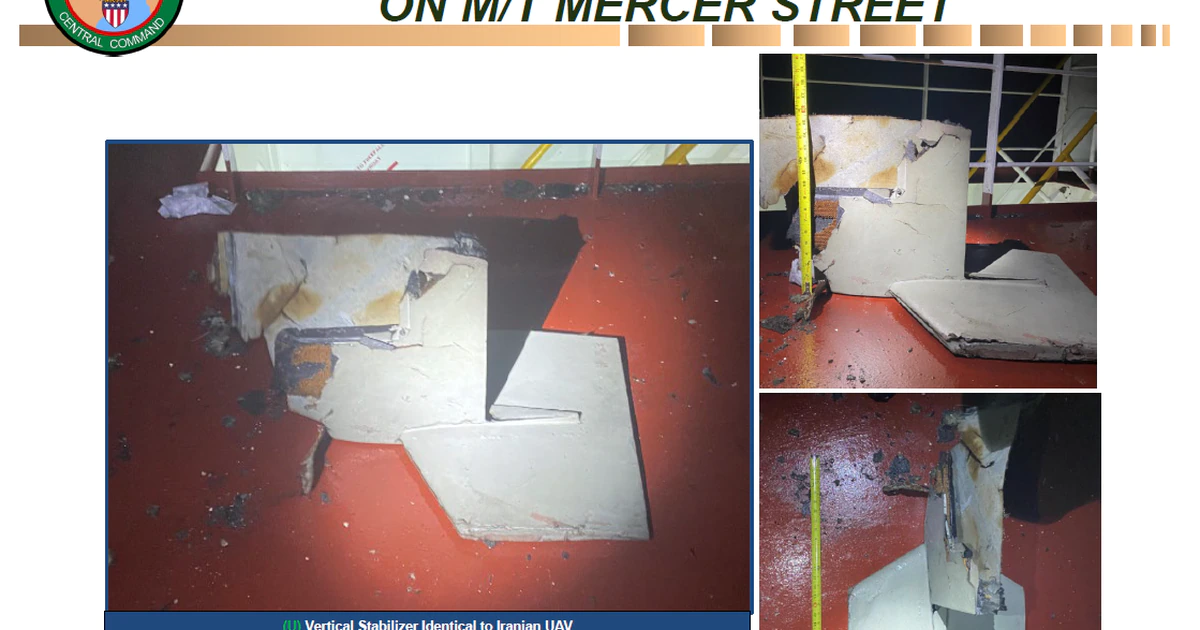
U.S. Central Command released evidence Friday that it says proves that an explosive aerial drone used in a July 30 fatal attack on the tanker ship Mercer Street off Oman was Iranian made.
While attacks on merchant ships in the Middle East have increased in recent years, the Mercer Street strike is believed to be the first such attack to result in loss of life.
The drone was carrying military-grade explosives, and wing wreckage recovered by Navy investigators matches known Iranian drones, according to the combatant command, which based its findings on an investigation conducted by a team from the aircraft carrier Ronald Reagan.
The carrier escorted the stricken ship to safety following the attack.
“Verified components of the Iranian one-way attack (drone) were identical to previously identified Iranian unmanned one-way attack systems,” the command said in a slideshow laying out its evidence.
The drone crashed into Mercer Street and detonated, leaving a 6-foot-wide hole in the pilot house while killing a Romanian citizen who was master of the ship and a British national working security, according to CENTCOM.
/cloudfront-us-east-1.images.arcpublishing.com/mco/TFGS5RHWPZDDTFOXOOXVRZ2HGY.png)
Explosive chemical tests revealed traces of RDX, a nitrate-based explosive, “indicating the (drone) had been rigged to cause injury and destruction,” the command said.
“Explosives experts were able to recover several pieces of this…UAV, including a vertical stabilizer…and internal components which were nearly identical to previously collected examples of Iranian one-way attack (drones),” CENTCOM said.
The distance from the Iranian coast to the attack location was also within the range of documented Iranian one-way drone attacks, according to CENTCOM.
Those recovered materials are being sent to a U.S. lab for further testing and verification.
Mercer Street suffered an unsuccessful explosive drone attack the day before the fatal strike, on July 29, in which the drones crashed into the ocean near the ship, according to CENTCOM.
Small remnants of those aircraft were pulled from the water by crew members.
British and Israeli explosives experts also reviewed the drone evidence at U.S. 5th Fleet headquarters in Bahrain and reached similar conclusions, CENTCOM said.
/cloudfront-us-east-1.images.arcpublishing.com/mco/YBB7IZDGKFEZDISBXYKBV6REYQ.jpg)
“This (drone) was produced in Iran,” the command said.
What this will mean for U.S. military efforts to counter Iran in the Middle East remained unclear Friday.
CENTCOM referred questions to the Pentagon and officials there did not immediately respond to requests for comment.
The ship is owned by an Israeli businessman, and that country’s defense minister said Thursday that the country is prepared to strike Iran following the Mercer Street attack, the Associated Press reported.
Speaking to the news website Ynet, Defense Minister Benny Gantz replied with a “yes” when asked if Israel was prepared to attack Iran, according to the AP.
“We are at a point where we need to take military action against Iran,” Gantz said. “The world needs to take action against Iran now.”
Tehran has denied involvement in the attack, and a spokesman for the Iran’s Foreign Ministry, Saeed Khatibzadeh, called Gantz’s saber rattling “another brazen violation” of international law, the AP reported.
“ANY foolish act against Iran will be met with a DECISIVE response,” Khatibzadeh said in a tweet, according to the AP. “Don’t test us.”
Other Iranian officials have blamed Israel this week for being the primary source of instability in the region, and criticized the country for attacking commercial vessels carrying oil and humanitarian aid to Syria, according to the AP.
Another provocation occurred earlier this week, when hijackers seized an asphalt tanker near the United Arab Emirates before leaving the vessel, the AP reported.
No one claimed responsibility for the attack on the Asphalt Princess, but the AP obtained radio communications showing that one of the ship’s crew members referred to armed Iranians boarding the ship.
Iran has denied involvement in the incident, according to the AP, calling such recent incidents in the region “completely suspicious.”



Be the first to comment